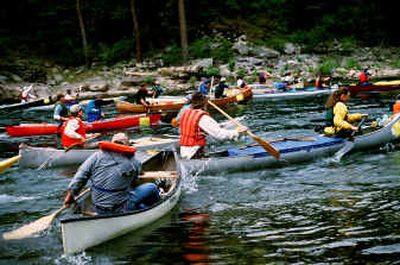Strokes of genius

Anybody can paddle a canoe.
But the ranks are considerably more exclusive when it comes to paddling efficiently, keeping a straight course and turning with precision.
“I did a lot of canoe trips before I went to instructor school and found out how little I knew,” said Brian Burns, a member of the Spokane Canoe and Kayak Club.
Different strokes work for different folks, he said, but some strokes work better than others.
Most people think they’re born knowing how to canoe, he said.
Or maybe they think they learned all about canoeing one afternoon years ago when they were plopped in a boat with an equally clueless partner at summer camp.
“It doesn’t look so intuitive when you see them out there flailing and zigzagging along switching sides constantly,” he said.
Anyone with an open mind and an experienced teacher can quickly learn the basic j-stroke, draw and pry, he said.
Tandem-canoe racers that lead the Spokane River Canoe Classic simultaneously snap paddles to opposite sides every four to eight strokes in order to maintain a straight course while both paddlers apply full forward power to each stroke.
Recreational paddlers, however, can enjoy a more leisurely paddling cadence and avoid switching sides if the stern paddler uses a J-stroke to correct the course of the canoe.
Burns teaches a stroke that’s fairly short, using torso rotation for power instead of doing all the work with the arms.
“Especially in the bow, the stroke shouldn’t come all the way back otherwise it starts to become a turning stroke instead of a power stroke,” he said, noting that a little attention to technique pays big dividends.
“People who practice their paddling skills become more efficient and you have more fun because you don’t get tired.”
Practiced draw, pry and backpaddle strokes allows a canoe to be as maneuverable as a bicycle. Good paddlers can slide sideway to get a better look at a beaver den or duck into an eddy with a snappy U-turn to avoid downstream danger.
“It’s really fun teaching kids because they are so into learning while it might take a little longer with adults who seem to have their own bias and resistance to being told how to do something as basic as canoeing,” Burns said.
A good forum for learning is the annual paddling classes sponsored by the Spokane Canoe and Kayak Club.
“Canoeing with a group has so many benefits,” Burns said. “You get the benefit of a lot of experience and you have a group to go with, and safety point that can’t be overestimated.”
Burns capsized his canoe many times in rapids over the years as he pushed the limits of his skill level.
“That’s the way you improve,” he said. “And it really is a lot of fun, especially when you’re with a group so you can see what works and what doesn’t work and have rescue boats below the rapids to get your canoe if you take a swim.”
Couples often are encouraged to get in different canoes with different partners during the club’s paddling classes, Burns said, noting that it’s not uncommon to have tension between mates as they learn the sport.
“Whichever one is in the stern usually is a know-it-all,” Burns said. “You need to get them separated so the stern isn’t giving orders. If you’re not talking, you can listen and actually learn something.”
Burns is one of the club volunteers who waits in eddies below rapids to assist paddlers who might capsize during the annual Canoe Classic fun race down the Spokane River.
“Just go out and have fun and we’ll pull you to shore if you take a swim,” he said, noting that the race safety rules assure that paddlers wear lifejackets and the boats have flotation.
Canoeing isn’t a snobby sport, he said.
The race is well supervised and it’s a good time to go out and see what you can do,” he said.